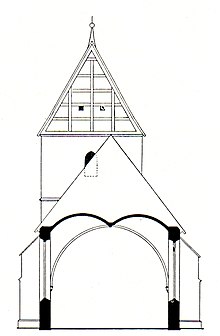Marienkirche (Wallenbrück)
St. Marien (also: Marienkirche ) is an Evangelical Lutheran parish church in Wallenbrück, East Westphalia (city of Spenge ).
history
Today's Lutheran parish church goes back to a medieval church founded around 1060. The Romanesque church tower as the oldest part of the church probably denotes the original longitudinal axis of the church, the later added Gothic nave protrudes clearly to the north. G. Jaszai from the Westfälisches Landesmuseum Münster dates the tower to around 1160/80, the broad, three- bay , single-nave hall construction of today's central nave around 1500.
In the course of the evangelical awakening movement of the 19th century, the number of people attending church services also increased significantly in Wallenbrück. As in 1877 in neighboring Spenge, St. Marien was expanded to the east. A crossing with two side aisles and a new choir room in neo-Gothic style were added to the first three bays .
The St. Marienkirche in Wallenbrück was originally a separate church. The first secured date can be found in the church itself on the epitaph for Gerhard the Friesen, which is inserted next to Gerhard's relief in the east wall of the south wing. The epitaph has a rotating Latin text that probably dates from the 11th century. The middle area originally had no text. Heinrich Rüthing from the University of Bielefeld assigns the later added Gothic minuscule to the 14th and 15th. Century too. After that this text was added about 350 years after the death of Gerhard. Rüthing freely translates the text:
Outer text: “In our opinion, the pious boy Gerhard, Eternal God, CCE (verb) ...”, inner text: “In the year of the Lord in 1060, Gerhard the Friesian, son of Pisenus, died here at the age of 12 and becomes held here for the founder of the church. "
In 1096 the nun Demod gave her own church and court in Wallenbrück to Bishop Wido von Osnabrück (Osnabrücker Urkundenbuch, vol. 1, 213). This is considered to be the first documentary mention of today's city of Spenge. The temporal proximity to the death of Gerhard could mean that the transference of the church is related to it. Demod could have donated it for her son who died young.
organ
The oldest parts of the organ of St. Mary's Church, an unknown organ builder, date back to before 1650. In 1659, Hans Heinrich Reinking renewed the work, which had suffered damage from a church tower fire, using older parts that had been preserved. The instrument initially had nine stops on a manual and an attached pedal . In the course of time, the organ was expanded, rebuilt and rearranged several times, with a lot of historical pipe material being lost. The case has also been redesigned several times. B. the gaming table was moved to the side. In 1715, Christian Vater added the breastwork as a further manual, and in 1892 the Klassmeier company carried out a major renovation , which switched the instrument to grinding chests and cone chests in the pedal.
In 1976 the organ was rebuilt by the organ building company Gustav Steinmann (Vlotho) using the five historical registers again. After significant lead oxidation was found on the old registers in 2008, the Wegscheider organ workshop removed the pipes and stored them in the Dresden workshop in order to restore them later. Since then, the listed housing on the west gallery has stood empty and awaits a reconstruction of the interior.
In the first phase of construction, organ builder Reinalt Johannes Klein expanded the rest of the modern inventory, including the technical work by Steinmann, from the historic case. He created a new organ case, which was built on the ground floor in the north aisle and protrudes into the gallery there. The registers and the overhauled and adapted technical system from Steinmann were built into the new housing and the missing five registers were added in the historical design so that the movement is complete again. The slider chest instrument today has 20 stops on two manuals and pedal. The actions are mechanical.
|
|
|
||||||||||||||||||||||||||||||||||||||||||||||||||||||||||||||||||||||||||||||||||||||||||||||||||||||||||||
- Coupling : II / I, I / P, II / P
literature
- Dietrich Korthals: The Marienkirche . In: Christine Hartmann (et al.): Traces of history in Wallenbrück and Bardüttingdorf. A history trail. Bielefeld 1992. pp. 156-181. ISBN 3-927085-55-3 .
Individual evidence
- ↑ Wallenbrücker Organ takes shape , accessed on January 4, 2017.
- ↑ More information about the organ. Retrieved November 22, 2014 .
Web links
Coordinates: 52 ° 9 ′ N , 8 ° 27 ′ E


